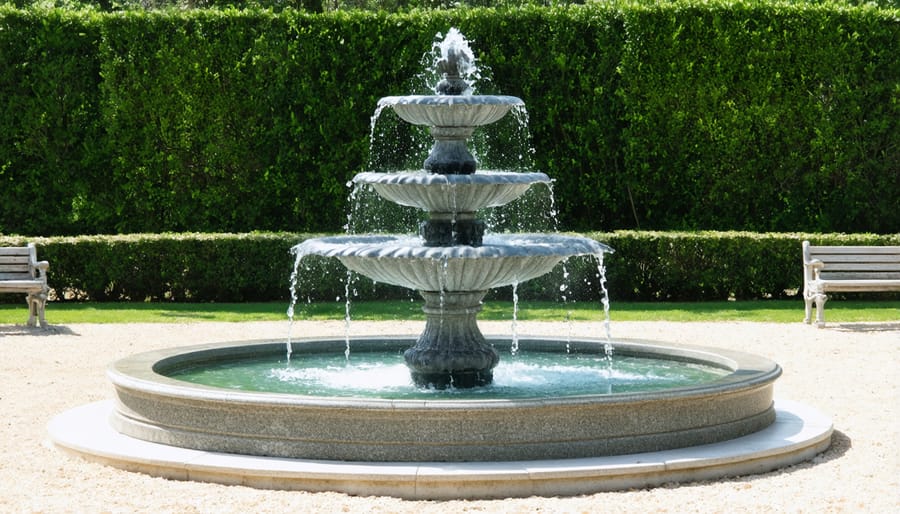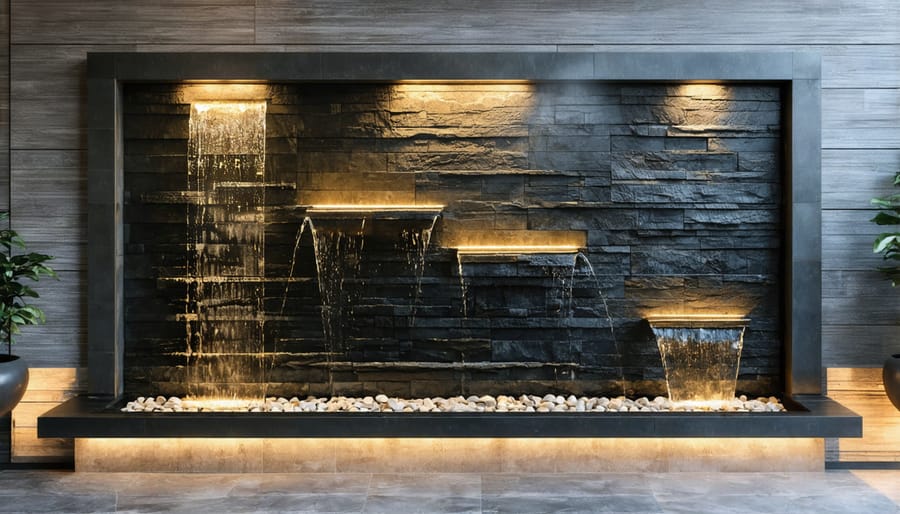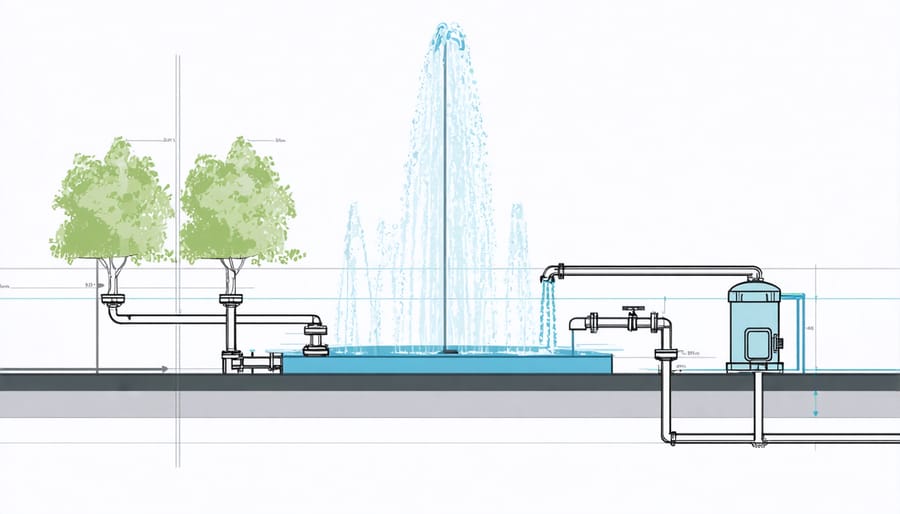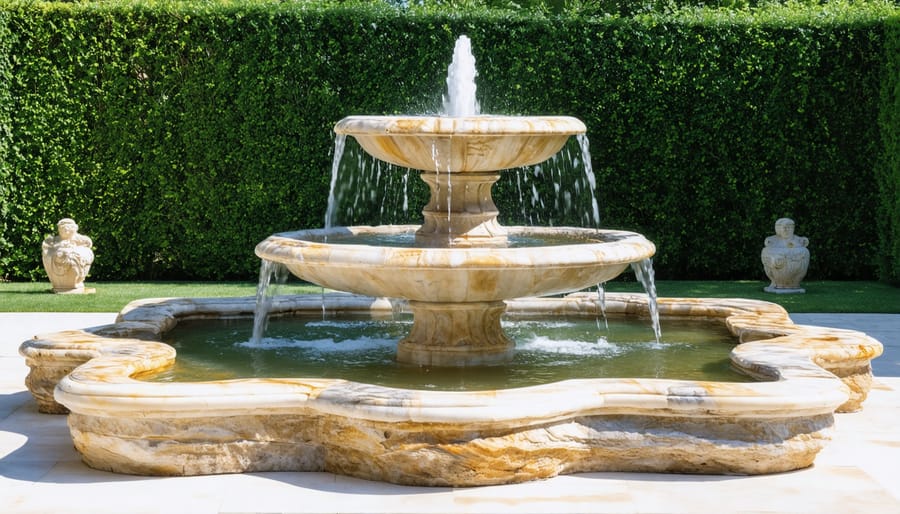Natural stone fountains transform ordinary gardens into mesmerizing outdoor sanctuaries, combining the timeless beauty of hand-carved limestone, granite, or marble with the soothing rhythms of flowing water. These architectural masterpieces not only enhance your outdoor space but also create a focal point that captures attention and elevates property value. From classical tiered designs that echo European courtyards to contemporary minimalist basalt columns, natural stone fountains offer unmatched durability and character that mass-produced alternatives simply cannot replicate. Each piece tells a unique story through its distinctive veining, color variations, and natural textures, while providing the practical benefits of humidity control and ambient noise reduction. Whether nestled within a meditation garden or commanding attention in a grand entrance, these enduring works of art merge nature’s raw beauty with sophisticated engineering to create outdoor sanctuaries that grow more distinguished with age.
Popular Natural Stone Types for Outdoor Fountains
Granite Fountains
Granite fountains exemplify durability and timeless elegance in outdoor water features. Known for their exceptional strength and resistance to weathering, these fountains can withstand decades of exposure to the elements while maintaining their structural integrity. The natural crystalline structure of granite provides unique patterns and textures, with various stone finish options available to enhance its natural beauty. From polished surfaces that showcase the stone’s intricate mineral composition to flamed textures that create a non-slip finish, granite fountains offer both practical functionality and sophisticated aesthetics. Available in an array of colors, from deep blacks and rich browns to speckled grays and warm beiges, granite fountains provide endless design possibilities while requiring minimal maintenance to preserve their striking appearance.

Limestone Water Features
Limestone fountains exude timeless elegance with their warm, creamy tones and classic Mediterranean appeal. This sedimentary stone naturally complements both traditional and modern landscape designs while creating a soothing focal point. However, limestone requires careful consideration regarding maintenance due to its porous nature. Regular sealing is essential to protect against water absorption and mineral deposits, particularly in areas with hard water. While more delicate than granite or marble, limestone’s natural weathering can add character over time, developing a distinctive patina that many homeowners find appealing. For optimal longevity, experts recommend applying a penetrating sealer every 2-3 years and avoiding harsh cleaning chemicals that could damage the stone’s surface. Despite these maintenance requirements, limestone remains a popular choice for water features due to its authentic historical charm and versatility in design applications.
Marble Fountain Options
Marble fountains represent the pinnacle of luxury in outdoor water features, combining timeless elegance with exceptional durability. Available in classic white Carrara, warm Botticino, or dramatic black Marquina varieties, marble fountains offer sophisticated options for any landscape design. These natural stone masterpieces develop a unique patina over time, enhancing their character while maintaining structural integrity. Multi-tiered designs featuring intricate carving work showcase marble’s versatility, while modern minimalist styles emphasize the material’s natural veining and crystalline structure. The material’s natural cooling properties make it particularly suitable for outdoor settings, as it remains comfortable to touch even in direct sunlight. When properly sealed and maintained, marble fountains can withstand various weather conditions while retaining their refined appearance for generations.
Slate and Sandstone Choices
Slate and sandstone offer distinctive textures that create stunning natural stone fountains with authentic rustic appeal. Slate’s layered appearance produces dramatic water flow patterns, while its dark gray to black coloring adds sophistication to any outdoor space. The material’s natural cleft surface provides excellent traction and safety around water features.
Sandstone brings warm earth tones ranging from buff to rich terracotta, making it ideal for Mediterranean or desert-inspired landscapes. Its naturally rough texture creates gentle, musical water movements and helps mask water marks that typically develop on smoother stones. Both materials weather beautifully over time, developing unique patinas that enhance their organic character while maintaining structural integrity. When selecting between these options, consider your existing landscape elements and desired maintenance level, as sandstone may require more frequent sealing than slate.
Design Styles and Configurations
Wall Fountains
Wall fountains offer an elegant solution for spaces where ground area is limited, combining the tranquil effects of flowing water with sophisticated vertical design. These architectural features mount directly onto exterior walls, creating focal points that maximize visual impact while minimizing footprint. Natural stone varieties like slate, limestone, and travertine are particularly suited for wall fountains, offering durability and timeless appeal.
The cascading water effect creates gentle sounds that mask ambient noise while adding moisture to the surrounding air. Installation typically requires proper wall reinforcement and professional plumbing, but the result is a low-maintenance water feature that can transform courtyards, patios, or garden walls into serene retreating spaces.
Available in various heights and widths, wall fountains can be customized to complement existing architecture. Popular styles range from minimalist contemporary designs featuring smooth stone panels to elaborate Mediterranean-inspired pieces with carved details and multiple tiers. LED lighting options can enhance the water’s movement after dark, creating dramatic evening ambiance.

Tiered Fountains
Tiered fountains represent the epitome of classical elegance in outdoor water features. These multi-level arrangements, often inspired by European palace gardens, create a cascading effect as water flows gracefully from one basin to the next. Natural stone materials like limestone, travertine, and granite are expertly carved to form harmonious tiers that vary in size and complexity.
During water feature installation, each tier is precisely balanced to ensure optimal water flow and acoustic properties. The number of tiers typically ranges from two to four levels, with larger installations occasionally incorporating additional basins. Popular designs include the traditional wedding cake style, stepped cascades, and Tuscan-inspired arrangements.
The visual impact of tiered fountains makes them ideal focal points for formal gardens, courtyard entrances, and circular driveways. Their symmetrical design provides a sense of order and sophistication while the sound of falling water creates a soothing atmosphere that enhances any outdoor space.
Basin and Bowl Designs
Modern basin and bowl designs embrace clean lines and geometric shapes, offering a sophisticated take on traditional fountain aesthetics. Circular and square basins dominate contemporary designs, with sleek overflow edges that create a seamless water sheet effect. Popular options include floating sphere fountains nestled in minimal stone basins and cubic vessels with cascading water features.
Natural stone choices for these contemporary designs often feature honed granite, smooth limestone, or polished basalt, selected for their understated elegance and durability. Many designs incorporate LED lighting beneath water surfaces, creating dramatic evening displays while maintaining the fountain’s minimalist appeal.
Single-tier bowls, often elevated on pedestals, provide focal points for meditation gardens and entry courtyards. For larger spaces, multi-tiered arrangements using identical geometric shapes create visual harmony while maintaining modernist principles. These simplified designs particularly complement architecture featuring glass, steel, and clean stone facades.
Custom Sculptural Pieces
Custom sculptural pieces represent the pinnacle of natural stone fountain artistry, where each installation becomes a unique masterpiece. These bespoke creations allow homeowners and designers to incorporate personalized elements that reflect specific architectural themes or landscape designs. Master stone artisans hand-carve intricate details into limestone, granite, or marble, creating one-of-a-kind water features that serve as focal points in any outdoor space.
From abstract contemporary designs to classical figurative sculptures, these custom pieces can range from intimate garden features to grand estate centerpieces. The creative possibilities are limitless – incorporating multiple water levels, LED lighting effects, or even integrating existing landscape elements. Skilled craftsmen can work with clients to develop pieces that complement surrounding structures while ensuring proper water flow and structural integrity.
Many custom installations also feature specialized finishes or textures that enhance the stone’s natural beauty and create unique water patterns, adding both visual and auditory dimensions to the outdoor environment.
Installation and Maintenance Requirements
Site Preparation and Foundation
Proper site preparation and foundation work are crucial for the longevity and stability of your natural stone fountain. Begin by selecting a level area with adequate drainage, away from tree roots and underground utilities. The soil must be compacted and tested for load-bearing capacity, especially for larger fountains weighing several hundred pounds.
Create a concrete pad foundation at least 4-6 inches thick, extending 6 inches beyond the fountain’s footprint on all sides. For heavier installations, consider reinforcing the concrete with rebar. The pad should be perfectly level and allowed to cure completely before fountain installation, typically 7-10 days depending on weather conditions.
Install a compacted gravel base beneath the concrete pad to enhance drainage and prevent settling. This base layer should be 4-6 inches deep and consist of crushed stone or gravel. For regions with freeze-thaw cycles, extend the foundation below the frost line to prevent winter damage.
Include conduits for electrical and plumbing connections during foundation preparation, ensuring they’re properly sealed and waterproofed. This forward planning prevents future disruption to the landscaping and ensures a clean, professional installation.
Water Systems and Plumbing
The heart of any outdoor fountain lies in its water system, centered around the submersible pump that circulates water throughout the feature. For natural stone fountains, pump selection requires careful consideration of both flow rate and head height to ensure optimal performance. A general rule is to choose a pump that can circulate the fountain’s entire water volume every hour.
Most residential stone fountains require pumps ranging from 250 to 1,500 gallons per hour, depending on size and desired water effects. The plumbing setup typically includes flexible PVC tubing connected to the pump, running through concealed channels within or behind the stone structure. Essential components include a check valve to prevent backflow, adjustable flow controls for fine-tuning water movement, and proper filtration to protect the pump from debris.
To maintain water quality and prevent mineral buildup, install an auto-fill valve to maintain consistent water levels. Additionally, incorporating a water treatment system helps prevent algae growth and mineral deposits that can stain natural stone. For areas with freezing temperatures, ensure all plumbing components are easily accessible for winterization.

Seasonal Care Guidelines
Proper seasonal maintenance ensures your natural stone fountain remains beautiful and functional throughout the year. During spring, thoroughly clean the basin and pump system, removing any debris accumulated over winter. Apply a fresh coat of sealant to protect the stone from increased moisture exposure.
Summer maintenance focuses on water quality and preventing algae growth. Check water levels daily, as heat increases evaporation. Add appropriate fountain treatments to prevent mineral buildup and maintain water clarity. Clean filters more frequently during peak operation months.
As autumn approaches, regularly remove fallen leaves to prevent staining and clogging. Install a protective mesh cover to minimize debris accumulation while allowing water flow. In regions with freezing winters, completely drain and dry the fountain before first frost. Store the pump indoors and cover the fountain with a breathable stone-specific cover.
For areas with mild winters, maintain water circulation to prevent freezing damage, but reduce the flow rate. Consider installing a fountain heater for added protection. Resume normal operation in spring after inspecting all components for winter damage.
Long-term Preservation
To ensure your natural stone fountain remains a lasting centerpiece of your outdoor space, implementing proper stone protection techniques is essential. Start by applying a high-quality penetrating sealer every 2-3 years to protect against water damage and staining. This creates an invisible barrier while maintaining the stone’s natural appearance.
Regular inspection for signs of wear, particularly in freeze-thaw climates, helps prevent structural issues. Address any cracks or chips promptly using appropriate stone-specific epoxy or patching compounds. Consider installing a water treatment system to prevent mineral buildup and discoloration from hard water.
During winter months in cold climates, either drain and cover the fountain or install a recirculating heater to prevent freeze damage. If moss or algae appear, use stone-safe biological treatments rather than harsh chemicals that could etch the surface.
Professional restoration services every 5-7 years can address deeper wear and maintain the fountain’s original beauty through cleaning, resealing, and structural repairs when needed.
Investment and Value Considerations
Natural stone outdoor fountains represent a significant investment in your property, with costs typically ranging from $2,000 to $15,000 for residential installations. Custom or larger commercial pieces can exceed $50,000. While the initial investment may seem substantial, natural stone fountains offer excellent long-term value due to their durability and timeless appeal.
The cost breakdown generally includes the stone materials (30-40% of total cost), craftsmanship and installation (40-50%), and water system components (10-20%). Factors affecting price include stone type, size, complexity of design, and installation requirements. Premium materials like marble or granite command higher prices than limestone or slate.
From a property value perspective, well-designed natural stone fountains can increase home value by 1-2% on average. Real estate professionals often cite water features as desirable amenities that enhance curb appeal and create memorable first impressions. In commercial settings, natural stone fountains can become signature elements that distinguish properties and attract tenants.
Consider the fountain an investment in both aesthetics and property value. While synthetic alternatives may cost less initially, natural stone’s longevity and appreciation potential often provide better returns over time. Annual maintenance costs are relatively modest, typically ranging from $200-600, depending on complexity and location. This predictable maintenance schedule helps protect your investment while ensuring the fountain remains an enduring asset to your property.
Natural stone outdoor fountains represent the perfect fusion of timeless elegance and natural beauty in landscape design. Throughout this guide, we’ve explored the diverse range of stone options, from classic marble to rugged granite, each offering unique aesthetic and practical benefits. Remember that successful fountain installation depends on proper planning, including consideration of size, location, and water systems. While natural stone fountains require specific maintenance to preserve their beauty, their durability and lasting appeal make them a worthwhile investment. Whether you choose a dramatic cascading waterfall or a simple bubbling basin, a natural stone fountain will create a stunning focal point that enhances your outdoor space for years to come. Consider working with experienced professionals for installation to ensure your fountain functions properly and remains a source of beauty and tranquility in your landscape.










